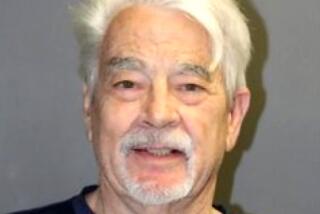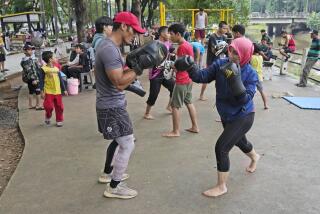Physicians Issue Alert on Violence
SAN FRANCISCO — The 3-year-old girl looked as if she were wearing red socks when Dr. Constance Battle saw her at the hospital. Both the child’s feet were evenly burned, with the damaged skin ending at a distinct line above the ankle.
The baby sitter, who had brought the girl to the emergency room, said her young charge was prone to misbehaving and in this instance had stepped into scalding water in the bathtub before the sitter could check the temperature.
Some physicians would have accepted that explanation without question.
But before beginning treatment for the burn, Battle silently observed that the normal way of stepping into a tub is one foot first. If the water is too hot, the foot would be hastily withdrawn. Because both feet were injured, the young patient clearly had been lowered into the hot water by an adult--either accidentally or intentionally, she concluded.
Battle, medical director of the Hospital for Sick Children in Washington, was one of a number of physicians and lay professionals at a recent meeting of the American Medical Women’s Assn. in San Francisco who urged that all physicians begin to look for injuries that appear inconsistent with the stories that patients, parents and caretakers tell. Such vigilance is necessary, they said, because violence has become a medical problem on a par with the No. 1 killer in the country, cardiovascular disease.
Explaining why women doctors were the ones to declare abuse, assault and battering as topics within the realm of medicine, a neurologist with the Brentwood Veterans Administration Medical Center, Dr. Michael Mahler, commented, “Women tend to be more exposed to that problem (violence) personally. With male doctors, that personal connection doesn’t seem to be as strong; there’s always a sense that we’re dealing with someone else’s problem.”
Mahler attended the meetings with his wife, Dr. Victoria Paterno, a Santa Monica pediatrician.
Traumatic Injuries
About 350 women physicians in attendance learned a new way of regarding any patient with a traumatic injury, regardless of the doctor’s specialty. It’s an approach that presupposes the possibility of abuse.
“You have to be alert, whether you’re in psychiatry or pediatrics,” said Battle, newly elected president of the 9,000-member American Medical Women’s Assn. “Radiologists have to be alert to bones that might be broken by someone else. Dermatologists have to look for patterns on the skin that might signal abuse. Internists and family-practice people who are treating the elderly need to be aware (of the possibility of violence).”
Dr. Jeanne Arnold, in family practice in Utica, N.Y., suggested that doctors routinely elicit a family history from every patient--asking questions such as, “Who in the family gives you trouble?”--as a way of ferreting out family violence.
The task need not be time-consuming, she said: “In five minutes, I can do a family history and find out whether a patient is at risk for family violence, or whether there’s alcoholism or incest in the family.”
A woman was admitted to the emergency room of her hospital in Utica several weeks ago, Arnold said, after she had been assaulted by her hammer-wielding husband. Neurosurgeons were able to repair the damage to the woman’s skull. But when the victim was well enough to go home to her husband, he lost his temper once again, and killed her.
Using Arnold’s method, the victim’s family physician would have identified the patient as at risk and sought help for her, and the death might have been averted.
Mapping the Targets
Arnold introduced the group to the “injury map,” a tool physicians can use to determine whether trauma to the body may have resulted from assault, even when the victim denies abuse. The image projected on the screen at the front of the conference room showed the head and neck to be the most common targets of punches and blows. The next most frequent points of attack are the upper torso, chest and thorax. Victims are less frequently beaten on the abdomen.
“We need to have a high level of suspicion (when examining patients),” Arnold said. Lingering psychosomatic complaints--tension headaches, vague abdominal pain--can really be symptoms of past or current abuse, she said. (Arnold urged doctors not to give tranquilizers when battering is suspected because a sedated victim may become despondent and attempt suicide.)
When a man reports he’s been lacerated by a tree branch, but seems to have the pattern of five fingernails across his face, or when a woman says she tripped off a curb but has bruises on her neck, Arnold said doctors need to ask: “Has anyone been hurting you?”
Ready for True Stories
But doctors who probe more deeply into causes of injury must be willing to set aside time to deal with emotional issues, and must be prepared to hear the truth, she cautioned. “The stories you will hear will be more shocking than anything in the soap operas or True Love magazine,” Arnold told the audience. “They’re true stories. You must believe them.”
When a patient goes home and tells the abuser that the doctor asked pointed questions about his or her bruises or cuts, that is sometimes enough to frighten the perpetrator and stop the violent behavior. But most often, the doctor will have to refer the patient to a shelter for battered women or other agencies that deal with child and spousal abuse or abuse of the elderly.
A show of hands revealed that while more than half the doctors in the room had seen brutalized patients in their practices, only a small number knew where to refer them. The panelists urged the doctors to find out about local resources for victims of violence when they returned to their communities.
“Its very difficult to treat such a victim fully,” said Dr. Lila Wallis, a clinical professor of medicine at Cornell University Medical College in New York City. She said an idea being considered at the conference was the formation of multi-specialty teams made up of physicians and mental health professionals to treat abuse victims.
‘I Was Mugged’
Dr. LeClair Bissell said that in New York City, where she lives and works, the most common story patients use to mask an assault by a friend or spouse is: “I was mugged.” Said Bissell, “I think we’ve been slow in asking these patients: ‘Have you been beaten? Have you been raped?’ And, ‘Have you been doing any beating?’ ”
And after these questions, there should be another set of standard queries regarding alcohol and drug abuse, said Bissell. In automobile accidents, the question of alcohol abuse is routinely raised. “That kind of questioning should be equally automatic in situations where violence is a factor,” she said, explaining that alcohol and drugs are often implicated in provoking violent behavior, and that alcoholism or drug addiction also may make a man or woman more prone to victimization.
“We’re not taught in medical school about these things at all,” said Bissell. “In medical school you only learn that if this particular bone is broken, this is how you fix it.”
Suicide Attempts
Bissell added self-inflicted violence to the list of acts discussed at the four-day conference. In the general population, women attempt suicide more often than men although men are more often successful, she said. But among woman physicians, she is finding a high rate of successful suicide. “Indeed,” she said, “the female physician looks more like the males in (numbers of) completed suicide.”
Bissell speculated that women doctors simply are more skilled at accomplishing their goal when it comes to suicide.
Battle added that physicians are also prey to family violence. She cited a recent report in the Pediatric News that spousal abuse was on the rise in doctor’s homes.
The women physicians at the conference agreed that they may be at the forefront of a medical counterattack on violence, precisely because they recognize such problems as suicide and spousal abuse within their own ranks. “We are not just talking about patients here,” Bissell said. “We’re talking about people, and that means us.”
More to Read
Sign up for Essential California
The most important California stories and recommendations in your inbox every morning.
You may occasionally receive promotional content from the Los Angeles Times.










